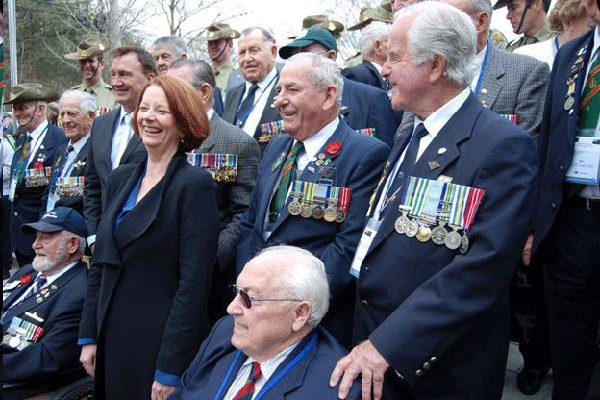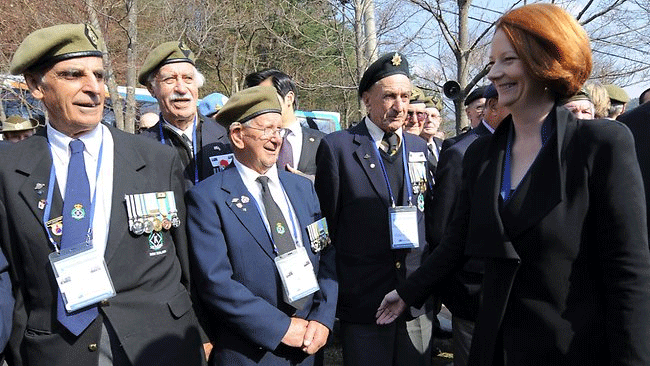KOREAN WAR VETERAN
Internet Journal for the World’s Veterans of the Korean War
January 14, 2016
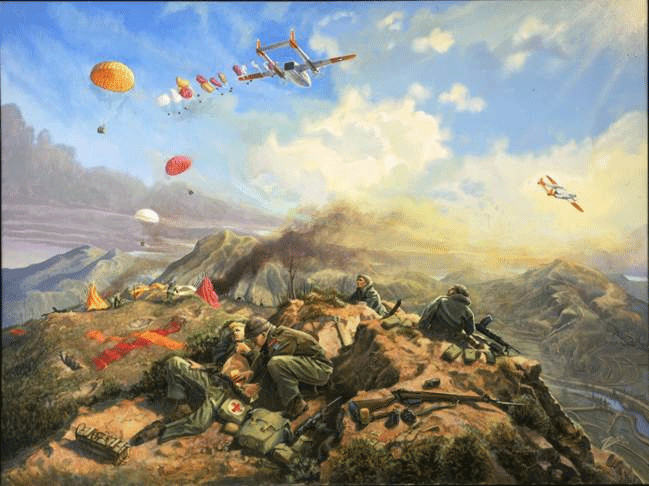
Holding at Kapyong – a famous painting by Canadian artist Ted Zuber, depicts troops from the 2nd Battalion, Princess Patricia’s Canadian Light Infantry, holding on “the knob,” the pinnacle of the great Hill 677 that the enemy tried to capture during the Battle of Kapyong in April, 1951. Ammunition, food and medical supplies are being air dropped by the U.S. Air Force, as the Canadians, for several hours, were cut off by infiltrating enemy units. The Kapyong River is depicted on the right side of the painting. The company medic represented in the painting actually was Private Donald Copley, who was Mentioned in Despatches for his bravery and unwavering service. After the war he attended university and medical school, then practiced medicine for many years. (The artist Ted Zuber served in Korea a little later on as a sniper with the 1st Battalion of The Royal Canadian Regiment).
Korea’s Ministry of Patriots and Veterans Affairs to hold commemoration ceremonies for veterans who fought in Battle of Kapyong and Battle of the Imjin River in April, 1951
In April, 2011 Korea’s Ministry of Patriots and Veterans Affairs (MPVA) held stirring ceremonies for veterans of both the Battle of Kapyong and the Battle of the Imjin River. The ceremonies marked the 60th anniversary of both battles, which occurred simultaneously at two different locations along the front, in April, 1951. Both battles were key in repelling the great spring offensive of the Chinese armies that sought to smash through the allied lines and reach the capital of Seoul. They didn’t do it.
Many of the veterans from Australia, Canada, New Zealand and the United Kingdom who participated in the 2011 ceremonies told one another it was likely the last time they would ever see the country, and possibly the last time they would see their comrades from other nations. Most of them were at least 80 years of age.
And now the MPVA, under Minister Park Sungchoon, is planning to hold commemoration ceremonies to mark the 65th anniversary of those battles. The Minister is hoping that veterans of the battles, who are healthy enough to make the journey, will sign up for the April Commonwealth Veterans Revisit Program. He wants every veteran of the battles to get the word, and to give consideration to returning to Korea. Now the youngest of those veterans will be 85 and some of them will be in their 90’s. But those who can, those who hear of the Minister’s plans to fete them in Korea, will try their utmost to be there. That is the kind of soldiers that they are.
The precise plans have not been made with ink as yet, and cannot be announced. Director Yongjin Jeon, who handles the MPVA’s international operations, has been burning the midnight oil with his team, formulating them.
The MPVA is bending over backwards to honor all Korean War Veterans. On January 12, for instance, Minister Park and his delegation were in Pierre, South Dakota, awarding nearly 500 Ambassador for Peace Medals to U.S. Veterans who live in the state. It was a momentous ceremony, with more than 200 veterans receiving the medals at a ceremony at the state capital. Some family members received the medals for those who are still listed as Missing in Action. The remainder of the medals were awarded to veterans in other locations throughout the state. All awards were made simultaneously, with the ceremony in the capital broadcast live throughout the state.
So that is an example of the great effort the Minister and his directors and international team are putting into programs to commemorate the veterans who served in Korea, and made that country free.
Yes, the youngest among the veterans of the two battles will be 85, and many will be older… but the world will be impressed with their resiliency and how they answer the call to be with their comrades on the soil where those battles were fought so desperately, so long ago. To them it is just an eye blink away from the realities of this day. South Koreans of like age were impressed by their bravery and sacrifice 65 years ago… and the young Koreans of this age will look upon them in wonder.
Korea’s Ministry of Patriots and Veterans Affairs to hold commemoration ceremonies for veterans who fought in Battle of Kapyong and Battle of the Imjin River in April, 1951
In April, 2011 Korea’s Ministry of Patriots and Veterans Affairs (MPVA) held stirring ceremonies for veterans of both the Battle of Kapyong and the Battle of the Imjin River. The ceremonies marked the 60th anniversary of both battles, which occurred simultaneously at two different locations along the front, in April, 1951. Both battles were key in repelling the great spring offensive of the Chinese armies that sought to smash through the allied lines and reach the capital of Seoul. They didn’t do it.
Many of the veterans from Australia, Canada, New Zealand and the United Kingdom who participated in the 2011 ceremonies told one another it was likely the last time they would ever see the country, and possibly the last time they would see their comrades from other nations. Most of them were at least 80 years of age.
And now the MPVA, under Minister Park Sungchoon, is planning to hold commemoration ceremonies to mark the 65th anniversary of those battles. The Minister is hoping that veterans of the battles, who are healthy enough to make the journey, will sign up for the April Commonwealth Veterans Revisit Program. He wants every veteran of the battles to get the word, and to give consideration to returning to Korea. Now the youngest of those veterans will be 85 and some of them will be in their 90’s. But those who can, those who hear of the Minister’s plans to fete them in Korea, will try their utmost to be there. That is the kind of soldiers that they are.
The precise plans have not been made with ink as yet, and cannot be announced. Director Yongjin Jeon, who handles the MPVA’s international operations, has been burning the midnight oil with his team, formulating them.
The MPVA is bending over backwards to honor all Korean War Veterans. On January 12, for instance, Minister Park and his delegation were in Pierre, South Dakota, awarding nearly 500 Ambassador for Peace Medals to U.S. Veterans who live in the state. It was a momentous ceremony, with more than 200 veterans receiving the medals at a ceremony at the state capital. Some family members received the medals for those who are still listed as Missing in Action. The remainder of the medals were awarded to veterans in other locations throughout the state. All awards were made simultaneously, with the ceremony in the capital broadcast live throughout the state.
So that is an example of the great effort the Minister and his directors and international team are putting into programs to commemorate the veterans who served in Korea, and made that country free.
Yes, the youngest among the veterans of the two battles will be 85, and many will be older… but the world will be impressed with their resiliency and how they answer the call to be with their comrades on the soil where those battles were fought so desperately, so long ago. To them it is just an eye blink away from the realities of this day. South Koreans of like age were impressed by their bravery and sacrifice 65 years ago… and the young Koreans of this age will look upon them in wonder.
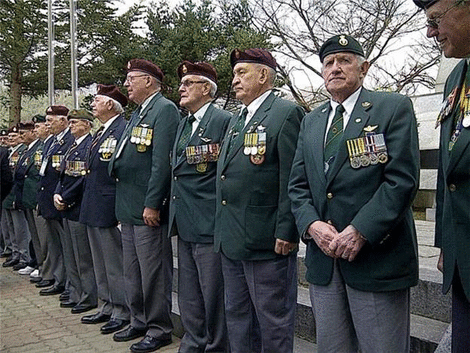
The 16 Field Regiment of the Royal New Zealand Artillery fired furiously throughout the battle for both the 3rd Battalion, The Royal Australian Regiment and the 2nd Battalion, Princess Patricia’s Canadian Light Infantry. The two battalions held positions respectively on the east and west sides of the Kapyong River Valley. The Royal Australian Regiment came under attack first and fought a heroic battle, being hit again and again by enemy infantry. They suffered extremely high casualties and were virtually out of ammunition, food and medications after more than 24 hours of relentless enemy attacks. Finally, they were forced to make a successful company-by-company withdrawal, with the rear company staying in contact with the pursuing enemy, then passing through while the one ahead formed a firm base. They stayed in continuous contact with the enemy as they leapfrogged their way back toward the Regimental headquarters. Most of their wounded were taken out by tanks of A Company, the 72nd U.S. Heavy Tank Battalion. Many of the walking wounded fought their way out with their comrades. They withdrew with many enemy prisoners in tow, who were carrying some of the wounded Australians on stretchers and lugging Australian equipment, including weapons of the fallen and the wounded. Major Ben O’Down, who had commanded all of the companies in the forward positions, and organized and led the righting withdrawal was never decorated for his outstanding service. His commanding officer was awarded the Distinguished Service Order.
Australian veterans should make revisit inquiries with Vice Dey, president of the Korea Veterans Association of Australia [email protected] or Harry Spicer of the Australian Council of Korean War Veterans [email protected]
Proud veterans of the Princess Patricia’s Canadian Light Infantry returned to Gapyeong in April, 2011 for 60th anniversary of the Battle of Kapyong ceremonies held by Korea’s Ministry of Patriots and Veterans Affairs, with participation by the defence attaches of the Australian, Canadian and New Zealand embassies. The veteran in foreground looking toward camera is Bernard Cote, one of the first soldiers from Ontario to volunteer to serve in Canada’s Special Force.
Prior to Canada forming the Special Force Brigade he had enlisted in the U.S. Army, giving an American address. The FBI arrested a large group of Canadians who had done the same on the troop train that was taking them to boot camp. Bernie and the other Canadian volunteers were bounced back to Canada. A volunteer from another country needed an immigrant visa to join the U.S. Army.
He fought in the attack by his company on Hill 532 in March, 1951. It was an all-day attack with fixed bayonets. When the battalion’s commanding officer went on the hill the next day he reported that there was a great track of blood all the way down the rear slopes from the wounded soldiers who had been carried away during the fighting.
The Patricias had finally been taken out of the line for a rest in April. They no sooner set up their new base than Brigade ordered them forward, along with the 3rd Royal Australian Regiment, to set up blocking positions in the Kapyong River Valley to hold back advancing enemy formations. Bernie was positioned in 10 Platoon, D Company, on “the knob,” the very summit of Hill 677 that the enemy tried to seize. He never talks about his service in the battles and fully intends to participate in the 2016 65th anniversary of the Battle of Kapyong ceremony in Korea.
Australian veterans should make revisit inquiries with Vice Dey, president of the Korea Veterans Association of Australia [email protected] or Harry Spicer of the Australian Council of Korean War Veterans [email protected]
Proud veterans of the Princess Patricia’s Canadian Light Infantry returned to Gapyeong in April, 2011 for 60th anniversary of the Battle of Kapyong ceremonies held by Korea’s Ministry of Patriots and Veterans Affairs, with participation by the defence attaches of the Australian, Canadian and New Zealand embassies. The veteran in foreground looking toward camera is Bernard Cote, one of the first soldiers from Ontario to volunteer to serve in Canada’s Special Force.
Prior to Canada forming the Special Force Brigade he had enlisted in the U.S. Army, giving an American address. The FBI arrested a large group of Canadians who had done the same on the troop train that was taking them to boot camp. Bernie and the other Canadian volunteers were bounced back to Canada. A volunteer from another country needed an immigrant visa to join the U.S. Army.
He fought in the attack by his company on Hill 532 in March, 1951. It was an all-day attack with fixed bayonets. When the battalion’s commanding officer went on the hill the next day he reported that there was a great track of blood all the way down the rear slopes from the wounded soldiers who had been carried away during the fighting.
The Patricias had finally been taken out of the line for a rest in April. They no sooner set up their new base than Brigade ordered them forward, along with the 3rd Royal Australian Regiment, to set up blocking positions in the Kapyong River Valley to hold back advancing enemy formations. Bernie was positioned in 10 Platoon, D Company, on “the knob,” the very summit of Hill 677 that the enemy tried to seize. He never talks about his service in the battles and fully intends to participate in the 2016 65th anniversary of the Battle of Kapyong ceremony in Korea.
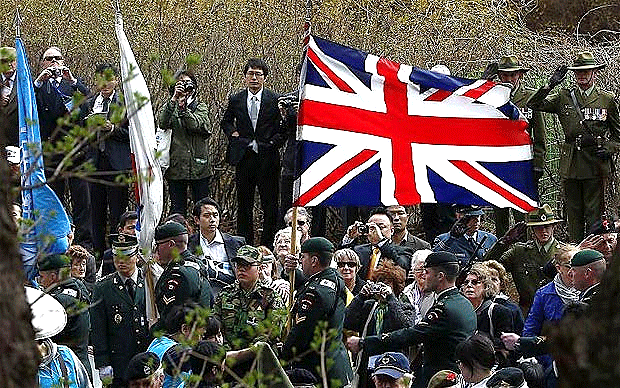
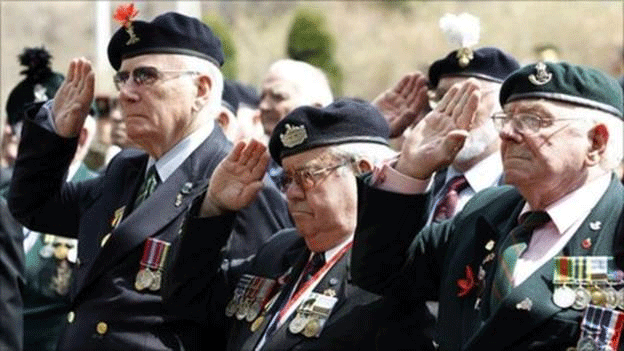
Veterans from the units of the British 29th Independent Infantry Brigade salute during a service near Solma-ri, marking the 60th anniversary of the Battle of the Imjin River in 2011.
Fighting in the nearly week-long Battle of the Imjin River were the 1st Battalions of the Gloucestershire Regiment; the Royal Northumberland Fusiliers; the Royal Ulster Rifles; the 8th King’s Royal Irish Hussars, and the 45th Field Regiment and 170 Independent Mortar Battery of the Royal Artillery. Part of the Brigade at the time was the Belgian Battalion, with the Luxembourger Platoon attached.
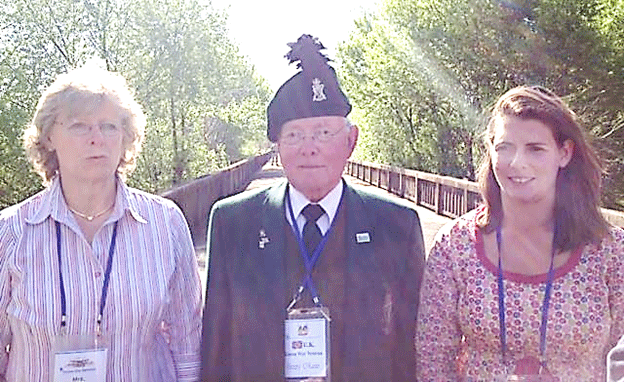
It is unfortunate that Henry O’Kane, the husband of BKVA revisit coordinator Charlotte O’Kane, who had served in the Battle of the Imjin River with the Royal Ulster Rifles, passed away on January 5, 2016.
The late Henry O’Kane shown with his wife, Charlotte and their daughter Melissa.
Henry O’Kane had fought in the tragic January 3, 1951 Battle of “Happy Valley,” in which the Ulsters lost more men killed in action in a single day than many British units lost during the entire Korean War. Having survived that terrible night battle, Rifleman O’Kane was thrust into the thick of the Battle of the Imjin River that lasted from April 22 through April 25, 1951. The Ulsters, like the other units of the 29th Brigade fought off the enemy until their ammunition was exhausted.
Henry O’Kane and many of his comrades were taken prisoner when over-run by vast enemy forces. He then spent two-and-one-half years in a prisoner of war camp. Our heart goes out to Charlotte.

